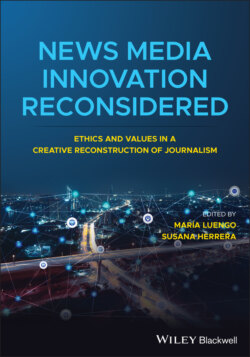Читать книгу News Media Innovation Reconsidered - Группа авторов - Страница 7
Seeing Creative Destruction as Creative Reconstruction
ОглавлениеPadioleau (2006, p. 10) is critical of the use of the term “creative destruction” in describing the crisis facing the media, on the basis that it is misleading. Is creative destruction a deceptive label? This terminology focuses mainly on economics and ignores the critical cultural and ethical component when explaining current changes in journalism. This book aims to put current technological innovations of journalism into the broader context of professional ethics and civil values. It examines journalism innovation from the energizing of ethics, looking at specific arenas of such innovation, from new forms and narratives to processes and ways of dissemination.
Without denying the tangible role played by digital technology and market conditions in reshaping the news today, this collaborative book takes a different angle to interpret recent changes in news media. Contrary to reductive techno-economic explanations, the contributors’ analyses of new journalistic forms and practices help show the power of journalistic and civil values for invigorating the profession. By looking at the ethical dimension of different initiatives and innovations in various countries, the chapters in this book seek to advance cultural and ethical insights into journalistic innovation.
Alexander (2016, p. 2) points out that:
Recent technological change and the economic upheaval it has produced are coded by social meanings … Cultural codes not only trigger sharp anxiety about technological and economic changes; they also provide pathways to control them, so that the democratic practices of independent journalism, rather than being destroyed, can be sustained in new forms.
Following Alexander, contributors to this book were invited to look at news media innovations from the ethical values that make technological innovation sustainable. The various contributions to this book make it possible to identify the ethical and professional codes that are invigorating the profession through digital technologies. The selected innovations are characterized by an online-only or online-first approach, conveying the news via websites, mobile apps, or social networks. They integrate experienced journalists, journalistic entrepreneurs, reporters, and computer scientists.
The ethical perspective deployed to cross-examine the different innovations discussed also serves as the basis for the theoretical argument behind this book: ethics and values can be envisioned as pathways to a creative reconstruction of journalism. This new conceptualization transcends the economic logic of a creative destruction, which, according to Alexander (2016), would result in the destruction of the economic foundations of journalism. “Journalism would become Exhibit A of capitalist ‘creative destruction,’” he observes [p. 7]. In this vein, in the following two sections, I wish to briefly draw attention to the performative power of journalism for innovative repair by looking at the professional and civil values that may be generating and sustaining new entrants in the news media digital ecosystem. To what extent does the ethics of journalism prevail and foster quality journalism through innovation within new disruptive digital scenarios? How are these ethical values shaped by new journalistic initiatives? To address these questions, I first use some of the closing remarks of Breese and Luengo’s (2016) “News Innovations and Enduring Commitments” chapter as scaffolding to semiotically map the arena of news media innovation as a symbolic place where journalism’s entrenched ethical codes are being re-signified. Then, I apply this theoretical framework performatively to new journalistic forms and practices at the intersection between ethics and technological innovation. This last section will serve as a more explicit introduction to the specific content of the chapters.
